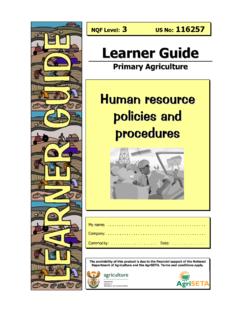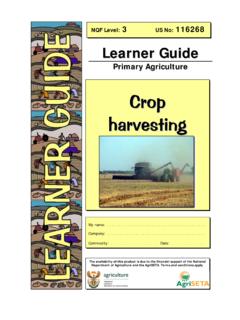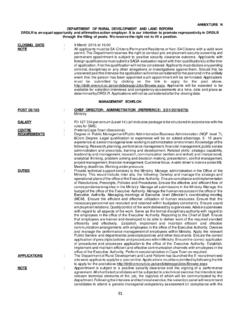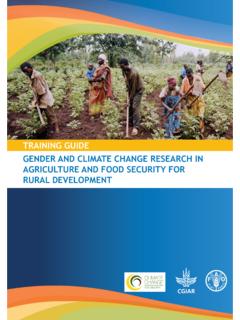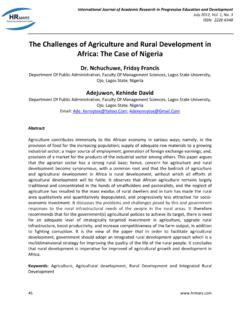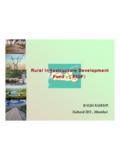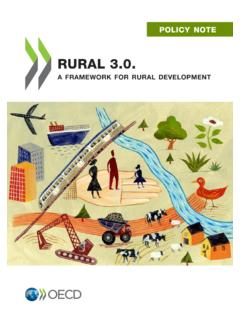Transcription of Rural Development in South Africa: The role of …
1 The Presidency Department of Performance Monitoring and Evaluation Rural Development in South africa : The role of Agriculture Tsakani Ngomane, PhD. AGRISETA ANNUAL SEMINAR. Kempton Park, South africa 21 September, 2012. Introduction Policies on aspects of Rural Development are being drawn up in developing contexts across the globe, responding to growing demands and diverse challenges For instance, a statement issued following a meeting of the G20 Agriculture Ministers (June, 2011) to address the issue of food price volatility, had this to say Food security will remain a critical issue for the international community, especially in developing countries. (today impact of US drought on food prices). World population is projected to reach more than 9 billion by the middle of this century. (20 million of world's poor and hungry live in SA). To strengthen food security, steps must be taken to improve access and availability of safe, sufficient and nutritious food for the most vulnerable, esp.
2 Women and children 2. The Presidency: Department of Performance Monitoring and Evaluation G20 Agriculture Ministers conti . The triple challenge for agriculture: meeting food security objectives while adapting to climate change and reducing its contribution to greenhouse gas emissions, requires improving the efficiency and adaptive capacity of agricultural systems Greater and sustainable productivity, better market information, comprehensive Rural Development and agricultural policies, and sustained investments enable agricultural producers to increase production, enhance their income and improve supply of food This in turn, requires decisive action: improvements in land and water management, improved agricultural technologies, well . functioning markets, and an enabling environment attractive to private sector 3. The Presidency: Department of Performance Monitoring and Evaluation Agricultural policies have an important role to play with regard to all these challenges, they said Given that small scale agricultural producers represent the majority of the food insecure in developing countries and the bulk of production in many countries Therefore, Increasing smallholder production and income would directly improve access to food among the most vulnerable households and improve supply for local and national markets This in turn, Will result in improved material and social conditions for millions of Rural communities and Rural households around the world.
3 4. The Presidency: Department of Performance Monitoring and Evaluation But then, What is our situation in South africa in as far as Development for Rural people and Rural areas is concerned? When we say Rural , or Rural Development , what do we mean, precisely? 5. The Presidency: Department of Performance Monitoring and Evaluation Problem Statement South africa 's economy has always been linked to the separate Development agenda, which has resulted in fragmented spatial Development planning along historical lines and patterns poor / no economic, social and cultural linkages to areas of economic activity, and relatively prosperous commercial and urban centres enduring underdevelopment with its social, economic, and cultural manifestations: poverty, gross income inequality, and chronic unemployment The major share of GDP contribution in former Homeland areas is represented by higher government salary payments, rather than increased production of goods and marketable services 6.
4 The Presidency: Department of Performance Monitoring and Evaluation Problem Statement cont Rural SA is a consumer society (NISS study, 2011: 96% of Rural people identified supermarkets as source of food supply!) Over half of h/holds in the former Homeland areas rely on social grants, or remittances for own livelihoods, but these are not strategically utilised to sustain the Rural economy Remittances & social grants are largely spent in support of formal big capital, which create a vicious cycle of poverty and inequality How can we better capitalise on the dynamic daily connections in the Rural economy? 7. The Presidency: Department of Performance Monitoring and Evaluation Impact of separate Development Segregated South africa into three kinds of social, economic and politico administrative spaces: o the major urban areas, which were a preserve of white people; o fertile commercial farming regions and associated small Rural towns (also a preserve for whites) & o Barren homelands' reserved for black people Under utilisation and/or unsustainable use of NRs Poor access to socio economic infrastructure and government services The Presidency: Department of Performance Monitoring and Evaluation Densely and Sparsely populated Rural areas Old Home land Areas (densely populated).
5 Sparsely populated Rural areas 9. Rural Development Framework (1997) defined Rural as . Sparsely populated areas in which people farm or depend on natural resources, including villages and small towns that are dispersed throughout these areas They include large settlements in the former homelands, created by apartheid removals, which have an economy based on external transfers for their survival ( migratory labour, social grants and remittances). Rurality refers to a way of life, a state of mind and a culture which revolves around land, livestock, cropping, use of natural resources, and community 10. The Presidency: Department of Performance Monitoring and Evaluation Key Policy Issues arising from definition Definition Some Policy issues Sparsely populated 1. How do we improve the agricultural economy areas (commercial and smallholder), green economy, tourism etc?
6 2. How do we maximise employment generation from these sectors? 3. How do we provide suitable services? They include large 1. How do we develop appropriate social services for settlements in former these areas? homelands 2. What can we do to develop a more viable economy in these artificial areas 1. How can we build sustainable livelihoods based on NR. Rurality - a way of and local culture? life, a state of mind 2. How can we empower Rural communities so that and a culture people can build on Rural culture and assets and create their own unique future? 11. The Presidency: Department of Performance Monitoring and Evaluation Agrarian Transformation for RD. 1. The debate about agrarian change and Rural Development begins with land as a national asset for food sovereignty and food security 2. The Rural Development policy framework is premised on the effects of the dispossession of land and systematic deprivation of land use rights, culture and social cohesion of Rural black South africa 3.
7 Success in land use and agricultural productivity is a Right based issue The Presidency: Department of Performance Monitoring and Evaluation Work done since 1994. Government instituted five tenets of the Reconstruction and Development Programme to deal with both Rural and urban poverty and transformation These are: meeting basic human needs, developing human resources; building the economy; democratising the state and society, and implementing the RDP.. The Presidency: Department of Performance Monitoring and Evaluation 13. Progress since 1994. ISRDP (2001). a) District level based interventions b) Unfunded programme c) Reliant on the coordination of the 3 spheres of government CRDP (2009). a) Household and War on Poverty ward level based (2008) interventions (wards). b) Funded a) Household level programme based interventions c) Based on a referral Rural Development (wards).
8 Framework (1997) systems to provide b) Unfunded better services to Not confirmed as programme Households policy c) Based on a "referral" d) Reliant on system to provide coordination and Reconstruction and better services to joint planning of the 3 Development Programme households spheres of (1994) government The Presidency: Department of Performance Monitoring and Evaluation Some Reflections on Lessons Learnt Rural Public policy was largely ineffective because: y It was not the product of informed public debate y It consisted of isolated elements of sectoral policy created without regard to inter sectoral effects, primarily focusing on short term priorities. y It was often urban policy that was poorly modified to fit nonurban settings y It was also based on the erroneous assumption that there are public institutions that serve the unique needs of Rural areas The Presidency: Department of Performance Monitoring and Evaluation A New Trajectory: Comprehensive Rural Development Plan The Presidency: Department of Performance Monitoring and Evaluation Tenure System Reform 1.
9 State and Public Land Don't sell lease hold Roads, bridges, energy, water 2. Private Land services, sanitation, Social infrastructure Tenure system review Free hold with limited library, cr ches, ICT infrastructure Strategic land reform extent early childhood interventions State the first right of Amenities centres, Police Restitution refusal when selling Facilities stations, clinics, houses, land ownership small Rural towns Precarious tenure revitalisation. A rapid and fundamental change in 4. Institution the relations (systems and patterns Land Management of ownership and control) of land, Commission livestock, cropping and community.' Power to subpoena Power to inquire on own volition or at the Food Security: Economic infrastructure Economic infrastructure instance of interested inputs: inputs: parties Strategic Partnerships: Agri-parks, fencing, Abattoirs, animal handling Power to Mentoring seeds, fertilizer, facilities, feed-lots, verify/validate title Co-management extension support , mechanising stock water deeds Share equity dams, dip tanks, Demand declaration of etc Modalities being windmills, fencing, Land holdings worked out between Grant amnesty or harvesters, etc the Dept and farmers; prosecute big and small Valuer General Phase III.
10 LRMB. Phase II Agro-village industries; Rural Development credit facilities Monitors (Rangers). Enterprise Rural Phase I Development Institution: Development measurables Rural Development Meeting Basic Agency Human Needs - Rationalize some existing institutions 1. Sustainability Conditions economic Development socio cultural Development : health, education and recreation environmental Development institutional / political support Aesthetic relational values The Presidency: Department of Performance Monitoring and Evaluation Aligned to Key Government Initiatives New Economic Growth Path, 2010: o provides further impetus to the vision for a transformed Rural sector o Prioritize job creation through infrastructure Development , agriculture, mining, manufacturing, the green economy , and tourism Industrial Policy Action Plan (IPAP2), 2010. o expand production in value added sectors with high employment and growth multipliers that compete in export markets as well as in the domestic market against imports The Presidency: Department of Performance Monitoring and Evaluation Key Performance Outputs for RD.






